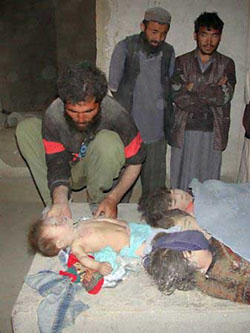The innocent dead in a coward's war
Estimates suggest US bombs have killed at least 3,767 civilians
The Guardian, December 20, 2001
Seumas Milne
The price in blood that has already been paid for America's war against terror is only now starting to become clear. Not by Britain or the US, nor even so far by the al-Qaida and Taliban leaders held responsible for the September 11 attacks on New York and Washington. It has instead been paid by ordinary Afghans, who had nothing whatever to do with the atrocities, didn't elect the Taliban theocrats who ruled over them and had no say in the decision to give house room to Bin Laden and his friends.
The Pentagon has been characteristically coy about how many people it believes have died under the missiles it has showered on Afghanistan. Acutely sensitive to the impact on international support for the war, spokespeople have usually batted away reports of civilian casualties with a casual "these cannot be independently confirmed", or sometimes simply denied the deaths occurred at all. The US media have been particularly helpful. Seven weeks into the bombing campaign, the Los Angeles Times only felt able to hazard the guess that "at least dozens of civilians" had been killed.
 | |
More photos |
Of course, Herold's total is only an estimate. But what is impressive about his work is not only the meticulous cross-checking, but the conservative assumptions he applies to each reported incident. The figure does not include those who died later of bomb injuries; nor those killed in the past 10 days; nor those who have died from cold and hunger because of the interruption of aid supplies or because they were forced to become refugees by the bombardment. It does not include military deaths (estimated by some analysts, partly on the basis of previous experience of the effects of carpet-bombing, to be upwards of 10,000), or those prisoners who were slaughtered in Mazar-i-Sharif, Qala-i-Janghi, Kandahar airport and elsewhere.
Champions of the war insist that such casualties are an unfortunate, but necessary, byproduct of a just campaign to root out global terror networks. They are a world apart, they argue, from the civilian victims of the attacks on the World Trade Centre because, in the case of the Afghan civilians, the US did not intend to kill them.
In fact, the moral distinction is far fuzzier, to put it at its most generous. As Herold argues, the high Afghan civilian death rate flows directly from US (and British) tactics and targeting. The decision to rely heavily on high-altitude air power, target urban infrastructure and repeatedly attack heavily populated towns and villages has reflected a deliberate trade-off of the lives of American pilots and soldiers, not with those of their declared Taliban enemies, but with Afghan civilians. Thousands of innocents have died over the past two months, not mainly as an accidental byproduct of the decision to overthrow the Taliban regime, but because of the low value put on Afghan civilian lives by US military planners.
Raids on targets such as the Kajakai dam power station, Kabul's telephone exchange, the al-Jazeera TV station office, lorries and buses filled with refugees and civilian fuel trucks were not mistakes. Nor were the deaths that they caused. The same goes for the use of anti-personnel cluster bombs in urban areas. But western public opinion has become increasingly desensitised to what has been done in its name. After US AC-130 gunships strafed the farming village of Chowkar-Karez in October, killing at least 93 civilians, a Pentagon official felt able to remark: "the people there are dead because we wanted them dead", while US defence secretary Donald Rumsfeld commented: "I cannot deal with that particular village."
Yesterday, Rumsfeld inadvertently conceded what little impact the Afghan campaign (yet to achieve its primary aim of bringing Bin Laden and the al-Qaida leadership to justice) has had on the terrorist threat, by speculating about ever more cataclysmic attacks, including on London. There will be no official two-minute silence for the Afghan dead, no newspaper obituaries or memorial services attended by the prime minister, as there were for the victims of the twin towers. But what has been cruelly demonstrated is that the US and its camp followers are prepared to sacrifice thousands of innocents in a coward's war.
s.milne@guardian.co.uk
Meanwhile, Back in Afghanistan... The full human cost of US air strikes will never be known, but many more died... Afghans are still dying as air strikes go on. But no one is counting US Raid Kills 100 Afghans U.S. Bombing Kills Up to 40 in Afghanistan-Reports Up to 60 die as US bombs tribal leaders by mistake War US Bombs Wipe Out Farming Village 4 U.N. Workers Killed in Initial Strike on Afghanistan Hundreds of Pakistanis believed massacred UN Reports Mazar-e-Sharif Executions Kabul residents fear northern alliance, worry for their safety Kabul